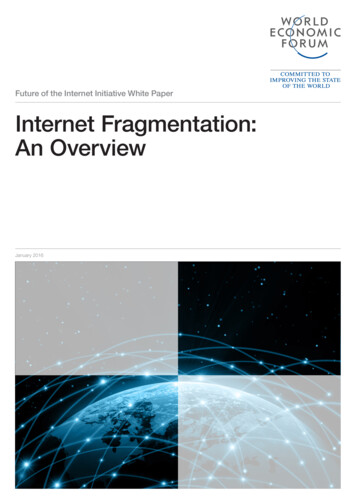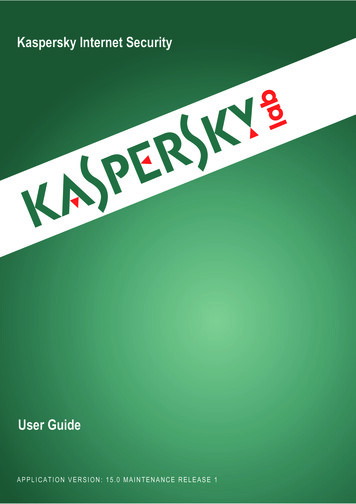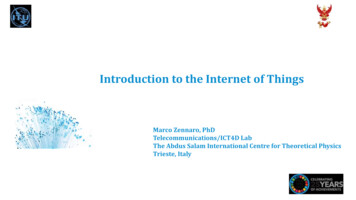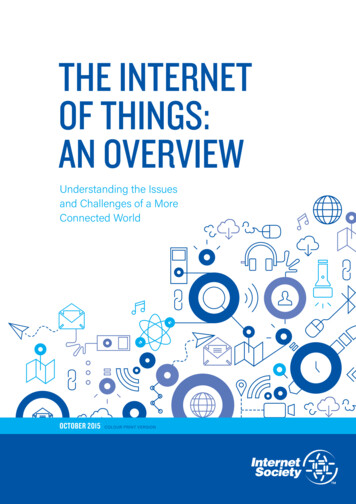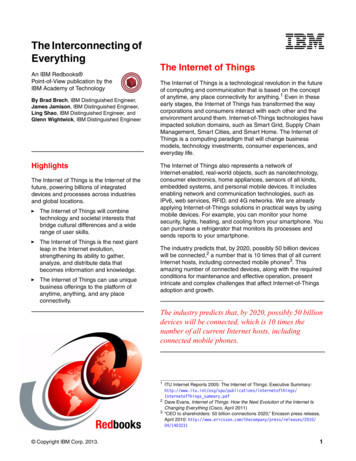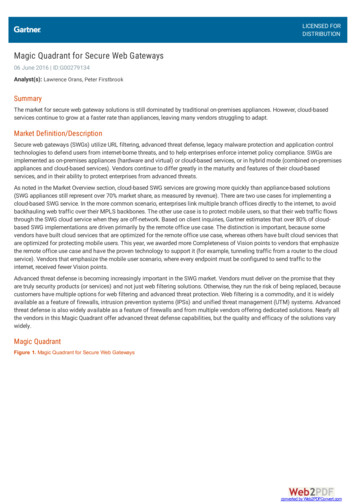
Transcription
Πολυμεσικό Υλικό στο Internet:Συγχρονισμός, Επεξεργασία καιΔιακίνησηMultimedia Content Delivery in the Internet: CDNs, RealTime Streaming, Multimedia platforms & video serviceproviders15/12/2016Β. Μάγκλαρης maglaris@netmode.ntua.gr Μ. Γραμματικού mary@netmode.ntua.gr Δ. Καλογεράς dkalo@noc.ntua.ge www.netmode.ntua.gr
Outline Content Delivery Networks (CDNs) Video on Demand servers/clouds Real Time Streaming
Content Delivery Networks (CDNs)http://en.wikipedia.org/wiki/Content delivery network The first generation CDNs were not encountered before the late 90′s CDN is a large distributed system of servers deployed in multiple datacenters across the Internet It serves content to end-users with high availability and highperformance without latency It serves a large fraction of the Internet content :– including web objects (text, graphics and scripts), downloadable objects(media files, software, documents), applications (e-commerce, portals),live steaming media, on-demand streaming media, and social networksSingle serverdistributionCDNdistribution
Notable Content Delivery Service Providershttp://en.wikipedia.org/wiki/Content delivery networkFree CDNs[edit] BootstrapCDN CloudFlare Coral Content Distribution Network Incapsula (free version with Incapsula advertisement)Traditional commercial CDNs[edit] Akamai Technologies Amazon CloudFront Aryaka Windows Azure CDN CacheFly CDNetworks ChinaCache Cotendo (acquired by Akamai) Distil Networks EdgeCast Networks Highwinds Network Group HP Cloud Services Incapsula Internap LeaseWeb Level 3 Communications Limelight Networks MaxCDN MegaFon MetaCDN Mirror Image Internet NACEVI OnApp OVH Rackspace Cloud Files Speedera Networks (acquired by Akamai) StreamZilla CDN EuropeTelco CDNs[edit] AT&T Inc. Bharti Airtel Bell Canada BT Group Deutsche Telekom Hibernia Networks KT (formerly Korea Telecom) KPN Level 3 Communications MegaFon NTT Pacnet PCCW Qualitynet SingTel SK Broadband Tata Communications TeliaSonera Telecom Argentina Telecom Italia Telecom New Zealand Telefonica Telenor Telstra Telus Turk Telekom VerizonCommercial CDNs using P2P for delivery[edit] BitTorrent, Inc. Internap Pando Networks Rawflow
Some Historical Events that Speeded Up theDevelopment of CDN technologies 9/11 Terrorist attack: a sudden, unanticipated mass of Internet users tried to access the particularnews site, simultaneously. This caused severe caching problems, and finally more money invested indeveloping CDN hosting to provide protection from the flash crowds for the websitesAkamai Technologies evolved out of an MIT research effort aimed at solving the flash crowd problemBroadband Services Forum (BSF), ICAP forum, Internet Streaming Media Alliance organizations alltook initiatives to develop standards for delivering broadband content, streaming rich media content– video, audio, and associated data – over the InternetBy 2002, large-scale ISPs started building their own CDN functionality, providing customized servicesIn 2004, more than 3000 companies were found to use CDNs, spending more than 20 millionmonthlyIn 2005, CDN revenue for both streaming video and Internet radio was estimated to grow at 40%Combined commercial market value for streaming audio, video, streaming audio and videoadvertising, download media and entertainment was estimated at between 385 million to 452million in 2005In 2008 Amazon launched their Content Delivery NetworkIn 2011 AT&T announces their new cloud-based Content Delivery Network that enables content toflow from its 38 data centers around the world to reduce transit and latency timesIn May 2011, Google said it had 200,000 active applications and 100,000 active developers.The stocks of leading CDN market players (Akamai, Limelight, EdgeCast) slumped; Akamai’s totalrevenue for 2011 was 1,159 million, a 13% increase over 2010 revenue of 1,024 millionAkamai’s stock revenue for 2012 is reported to be 345.32 millionCisco projected 2012 Video CDN revenues at around 1 billion with growth for 2013 between 40%and 45%, and the complete market to grow from 6 billion to 12 billion by 2015.
CDN 2014 – 2017: Operations and 7274-cdn-2014-2017-operations-andanalytics.html CDN (Content Delivery Network) revenue is projected at 3.36billion in 2014, up 19%, directed by user appetite for self-selectedcontent Total 2013 commercial value of media and entertainment video(views and advertising), movie/TV files, music listening anddownloads (including self-hosting entities such as Google andAmazon) stood at 3.35 billion, of which 1.05 billion (31.3%) wasdelivered through CDN contracts Video viewing and advertising (combining self-hosted networks),TV/ movies and music accounted for 2.4 billion gigabytes of datatransfer, worth 1.6 billion in commercial market value (bandwidthand co-lo fees only), when priced at prevailing rates and against avolume (gigabytes delivered) model CDNs include Akamai Technologies, Limelight Networks, Cd Networks, China Cache,Mirror Image, Level 3, High winds, Cloud flare, Tata Communications and MaxCDN,among othersPublished By: AccuStream Research
CDN Providers uses differentBusiness Model Google maintains it’s own delivery network consistingof large number of GGC (Google Global Cache) nodesplaced on ISPs network and help in serving Google’sstatic content Akamai (whose core business is into Cache delivery)put their servers on large number of edge networksbut they stay as disconnected small islands New comers in the industry like Limelight, Cloudflareput node in major datacenter and direct connectionto major networks via peering from IXPs
CDN and Cloud content-delivery-networks-cdn In the past, the development of CDNs sought to dealwith extreme bandwidth pressures, first as videostreaming was growing in demand as well as thenumber of content providers Now, CDNs are a continual trend, with the emergenceof utility - cloud computing, charging end-users ondemand and involving all layers of cloud computing:– SaaS (Software as a Service), e.g. Google Docs, AmazonCloudFront– PaaS (Platform as a Service) e.g. Google App Engine– IaaS (Infrastructure as a Service), e.g. GRNET Okeanos,Amazon EC2
Layers of Cloud content-delivery-networks-cdn
Content Delivery NetworksContent Delivery Networks State of the Art, Insights, and Imperatives 2008,Mukaddim Pathan, Rajkumar Buyya and Athena Vakali Most CDNs are operated as an Application ServiceProvider (ASP) on the Internet (also known as ondemand software or SaaS) targeting ContentProviders, web administrators etc., wishing tooptimize delivery to end-users CDN Service and Functionalities:––––––Storage and Management of contentDistribution of content among edge serversCache managementDelivery of encoded mediaBackup and disaster recovery solutionsMonitoring and Performance
Content Νetworking Techniques The Internet was designed according to the end-to-end neutralityprinciple - Core network : simple and moves the intelligence to thenetwork end-points (hosts, clients) CDNs distribute a variety of applications employing techniques tooptimize content delivery. The resulting tightly integrated overlayuses web caching, server-load balancing, request routing, andcontent services– Web caches store popular content on servers that have the greatestdemand for the content requested– Server-load balancing uses one or more techniques including servicebased (global load balancing) or hardware-based A variety of algorithms are used to route appropriately the request,these include:–––––Global Server Load BalancingDNS-based request routingDynamic metafile generationHTML rewritingAnycasting
Algorithms used in Request Routing in rview-of-CDN-Content-Delivery-Network Global Server Load Balancing (GLSB): enables the content to beobtained from a server pool in a sequential manner using roundrobin method and redirect the request in case of inactive serversessions DNS-based request routing: when a request is made (URL), thelocal DNS server provides the IP address of the nearest matchingCDN node. If the Local DNS is not able to resolve the URL, itforwards the request to the Root DNS server, which then providesthe nearest possible CDN server IP Dynamic metafile generation includes creation of a metafile, whichhas an ordered hierarchy of CDN domains connected to a mainserver and helps in the load balancing on each of CDN nodesconnected to it
Protocols used in Request Routing in rview-of-CDN-Content-Delivery-Network ICAP (Internet Content Adaptation Protocol) is ahigh level protocol that helps in generating httprequests and delivers contents from the CDNservers– It is used to extend transparent proxy servers– ICAP concentrates on leveraging edge-based devices(cashing proxies) to help deliver value-added-services– The ICAP servers are focused on a specific function, forexample, virus scanning, content translation, languagetranslation, or content filtering
Protocols used in Request Routing inCDNs (II) OPES - RFC4037 (Open Pluggable Edge Services) uses aProcessor in order to share contents to the end users– This processor duplicates the content at each CDN nodeand traces the route followed by each request made bythe user and notifies the user once the content is found ESI (Edge Side Includes) avoids back end processingdelays hence providing dynamic contents with ease– It breaks web content into fragments and delivers dynamiccontents to end users (Akamai is a co-authored in thespecification)
P2P and Private CDNs Peer-to-peer CDNs– In P2P content-delivery networks, clients provideresources as well as use them, so the contentserving capacity of P2P networks canactually increase as more users begin to accessthe content Private CDNs– The owners create their own CDN– A private CDN consists of Points of Present (PoPs)that are only serving content for their owner
-how-it-works.html How it works: A CDN stores a cached version of its contentin multiple geographical locations Each PoP contains a number of cachingservers responsible for content delivery tovisitors within its proximity CDN a popular choice for: Advertising Media and entertainment Online gaming E-commerce Mobile Healthcare Higher education Government Every Second CountsStudies show that a second-long delay causes: a 7% drop in conversions an 11% drop in page views a 16% drop in customer satisfaction
CDN Building Blocks PoPs : reduce round trip time by bringing the content closer to the website’s visitor. EachCDN PoP typically contains numerous caching servers Caching Servers : main function is to accelerate website load times and reducebandwidth consumption. Each CDN caching server typically holds multiple storage drivesand high amounts of RAM resources SSD/HDD RAM : Inside CDN caching servers, cached files are stored on solid-state andhard-disk drives (SSD and HDD) or in RAM
CDN Generations 1stGen CDN - Static 2nd Gen-DynamicCDNCDN– Content servedStatic HTML anddownloadable files– Caching methodOrigin push– Network topologyScattered– AgendaPerformance– PricingVery expensive– CustomerCorporate sector– Content servedStatic and dynamiccontent, including richmedia– Caching methodMany are origin pull– Network topologyConsolidated– AgendaPerformance andavailability– PricingExpensive– CustomerBusiness sectors 3rd Gen - MultiPurpose CDN– Content servedStatic and dynamiccontent, includingmobile and rich media– Caching methodMost are origin pull– Network topologyHighly consolidated– AgendaSecurity, performanceand availability– PricingAffordable– CustomerAnyone with a website
CDN Architecture Basic building blocks ofCDN infrastructures arePoPs (Points of Presence) Multiple servers androuters responsible forcaching DDoS scrubbing serversand machines responsiblefor other security-relatedfunctions
CDN Round-Trip Time Round-trip time (RTT) is the number of milliseconds (ms) it takes for abrowser to send a request and receive a response back from a server RTT is affected by:– PhysicalDistances– Number ofIntermediate Nodes– Amount ofTraffic– TransmissionMediums
Pillars Performance– minimize latency Reliability– CDNs adopt a “no single point of failure” approach, both bycarefully phasing maintenance cycles and by integratingadditional hardware and software redundancy Scalability– processing resources on all levels—down to computing andcaching resources available on each of the caching servers Responsiveness– CDNs continually strive to improve responsiveness—measuredin the amount of time it takes for network-wide configurationchanges to take effect
CDN CachingCaching works by selectively storing website fileson a CDN’s cache proxy servers, where they canbe quickly accessed by website visitors browsingfrom a nearby location
CACHE SERVERS These points ofpresence (PoP) areselected based ontraffic patterns ofindividual regions Highly activelocations withnumerous usersmay have severaldata centers. Onthe other hand,remote locationswith few users mayhave only one PoPto cover a largeGeographic Region
Caching Algorithms - Cache Policy Efficient caching relies on a high hit ratio,which indicate that the requested resourcesare present in the cache General formula to calculate average memoryreference time is:Cache hit ratio measures the percentageof requests your CDN is able to servefrom its own internal cache (Cache HIT:Client to Edge) verse requests for assetsin which the CDN has to pass along toyour Origin (Cache MISS: Client to Edgeto Origin)
Classifying Your Cache Hit RatioCold Cache- Warm Cache – Hot Cache
Some of the Algorithms are usedto ensure high hit ratio Bélá
Akamai Technologies evolved out of an MIT research effort aimed at solving the flash crowd problem Broadband Services Forum (BSF), ICAP forum, Internet Streaming Media Alliance organizations all took initiatives to develop standards for delivering broadband content, streaming rich media content –video, audio, and associated data –over the Internet By 2002, large-scale ISPs .
